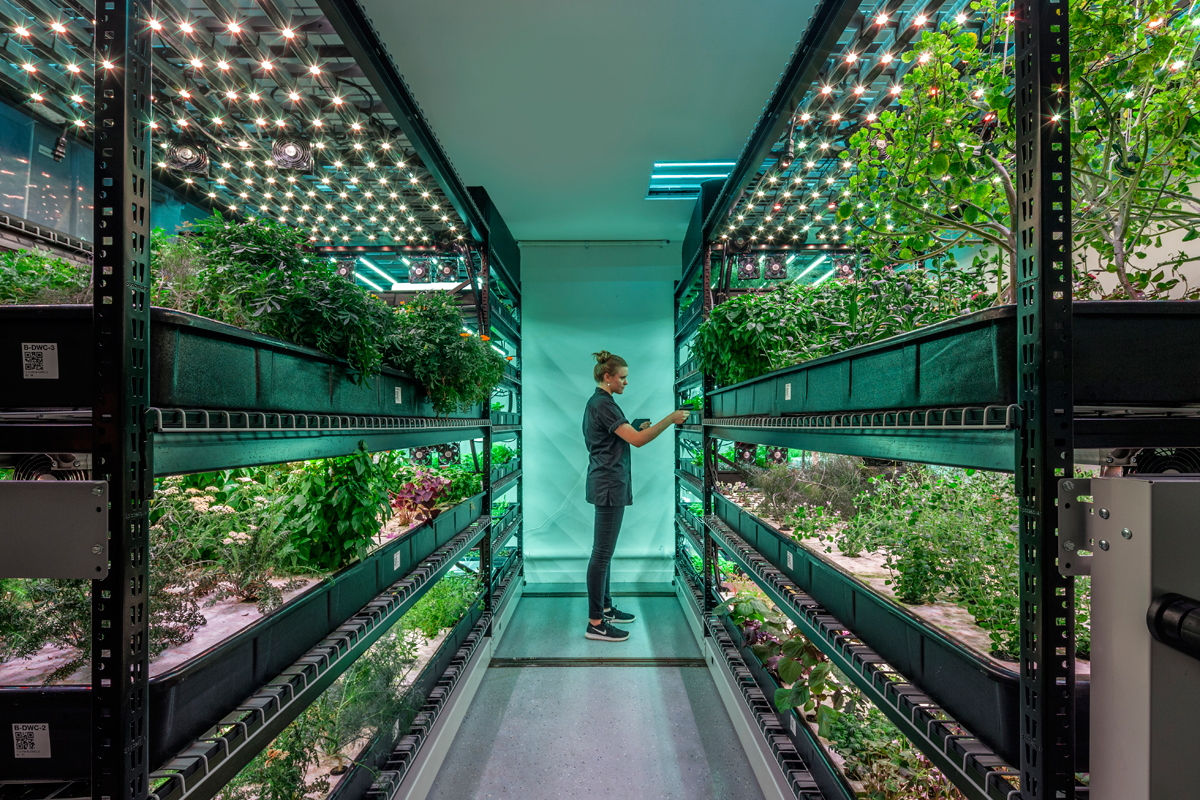By now, the images of shelves full of perfect greens in hulking warehouses, stacked floor to ceiling in sterile environs and illuminated by high-powered LED lights, have become familiar. Food futurists and industry leaders say these high-tech vertical farming operations are the future of agriculture—able to operate anywhere, virtually invincible against pests, pathogens, and poor weather, and producing local, fresh, high-quality, lower-carbon food year-round.
That future seemed one step closer to reality last year when San Francisco-based indoor farming startup Plenty, which grows a variety of salad and leafy greens hydroponically (without soil) and uses artificial lighting in facilities in three locations, announced that it had raised a whopping $200 million in funding from the SoftBank Vision Fund, whose investors include Amazon founder Jeff Bezos.
Flush with cash, Plenty quickly opened a 100,000-square-foot indoor farm outside Seattle that promised to produce 4.5 million pounds of greens annually—and testing some varieties not yet grown for the masses at scale, such as strawberries and tomatoes, at its research and development farm in Wyoming. To Plenty’s leadership and many observers, the cash influx signaled the economic promise of growing food indoors without sunlight and with less soil and water than field farming.

 Photo courtesy of Plenty.
Photo courtesy of Plenty.
“My reaction [to the $200 million round] was both that of validation, excitement,” said Matt Barnard, Plenty’s co-founder and CEO, over a manner of farming he says yields 350 times the produce per acre on one percent of the water used by dirt farming. “Now we must move with speed and efficiency if we’re to accomplish our mission of bringing people worldwide an experience that’s healthier for them and the planet.”
Not everyone is in agreement.
“My first thought was, ‘we could build a lot of greenhouses for $200 million,’” recalls Neil Mattson, a professor of plant science at Cornell and one of the country’s leading academic voices on indoor agriculture, who’s found that high-tech greenhouses that harness sunlight are more cost- and carbon-friendly than vertical farms that use artificial light.
Most vertical farmers are only hoping to claim a percentage of the conventional produce market, not replace it. To these founders and their investors, the market for lettuce and greens, especially—grown primarily in California and Arizona and shipped worldwide—is ripe for disruption. E. coli outbreaks like the one that hit Arizona-grown romaine lettuce earlier this year, killing a handful of people and sickening hundreds, only further their case.
But behind futurists’ fervent predictions about indoor agriculture, claims about product quality, and sexy technology lies a reality known by industry insiders but too often missing from media coverage: The future success of this nascent industry is still very much an open question.
The astronomical capital costs associated with starting a large hydroponic farm (compared to field and greenhouse farming), its reliance on investor capital and yet-to-be-developed technology, and challenges around energy efficiency and environmental impact make vertical farming anything but a sure bet. And even if vertical farms do scale, there’s no clear sense of whether brand-loyal consumers, en masse, will make the switch from field-grown produce to foods grown indoors.
Tricky Economics
Walking into any supermarket will reveal a small mountain of salad greens, carrying a price tag of between $9 and $12 per pound. They may be locally grown or organic, which will add $0.50 or $1 to the price tag. Meanwhile, a 4.5-ounce carton of Massachusetts-based FreshBox Farms’ spring mix—grown in the company’s hydroponic farm in Massachusetts—costs $3.99 for a 4-ounce box, or $15.96 per pound. Or kale: the conventional variety will run you $1.33 per pound at Walmart; organic kale costs around $4.99 per pound at Whole Foods; and vertically farmed kale grown at Newark, New Jersey-based AeroFarms will cost you a whopping $14.18 per pound.
That dramatic price gap is due to the millions of dollars currently needed to build one large indoor vertical farm—and that price is not going to drop until the industry scales up. Agritecture Consulting, whose clients include current and prospective indoor farms, estimates that a 30,000-square-foot vertical farm growing leafy greens and herbs in the tri-state area around New York City requires nearly $4 million in startup capital—not including labor.
They should know: In 2016, Agritecture built farm.one in Manhattan’s TriBeCa neighborhood, which supplies hydroponic greens and edible flowers to a number of the city’s top restaurants. Chefs have been quick to catch onto the value of consistent, year-round, locally grown produce.

 A farm.one indoor farming operation. (Photo courtesy of farm.one.)
A farm.one indoor farming operation. (Photo courtesy of farm.one.)
In 2016, AeroFarms, now considered an industry leader, spent $30 million on its flagship aeroponic farm in Newark. The majority of these costs lie in the equipment needed to grow greens without soil or sunlight—heating and cooling systems, ventilation, shading, environmental controls, and lights.
All of these costs add up to a hefty electricity bill: According to models compiled for Civil Eats by Agritecture, a 30,000-square-foot vertical farm in metro New York City should budget upwards of $216,000 annually for lighting and power, and another $120,000 on HVAC systems; costs will vary region to region depending on what each state charges for electricity.
